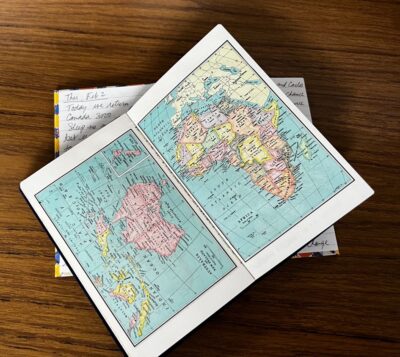I’m a big believer in journaling while traveling. All the material you find on my JoeTourist website about destinations I have visited are created from my journals. Although I refer below to paper journals, I always travel with a notebook computer and smart phone, so my journals are now created by typing and sometimes by using speech-to-text.

Keep a travel journal, and you will enjoy your travel and get more out of your experiences. You probably are not in the habit of keeping a journal at home, but bring along a small bound book with lined pages on your trip. Write the names and addresses of people you intend to write post cards to in the back of this book before you leave. Also write important info in the back of this book, such as your passport number, important bank and credit card info (account numbers, bank address and phone numbers, etc.), and any other info you think you might need on the trip.
Every day after you have settled into your hotel room for the night, sit down and write notes about everything that happened during the day just past in your journal. Don’t worry that some of your writings might seem trivial at the time. Be sure to write down any names of locales you visit and people you meet. Write down names, addresses or phone numbers. Write down the names of tour boats and their skippers, clothing vendors, bartender’s names, restaurant and other business names, etc. Grab a business card and a brochure, so you have the details without having to take notes. Business people do this all the time, to ensure they have a productive business trip, and for follow-up after they return home. If you think about it, travellers should do the same, to ensure they get maximum value out of their trip, and to help them remember the details later.
An excellent resource for travel journal writing is How To Write A Great Travel Journal. There are nine tips on how to stay motivated, and the importance of including details. “A travel journal is the best travel souvenir ever.”
Use your journal to tell stories, or write down stories told to you by the locals. Record travel times and distances between towns. Make the journal a ritual each night, and you will have a valuable record of your trip when you are back home. Take it from me, you will forget 99% of the details of your travels after only six months. The only memories that will live on are your photos and your notes in your travel journal. I also try to log my photos. You can do this in a general way using a journal, or you can use photo indexing software on a computer, if you’re a geek like I am. The aim is to help sort out what each photo (or groups of photos) are about. Sometimes simply noting the location is enough to jog your memory later when you return home.
An alternative approach to keeping a journal is to record your trip and speak narrative into digital camera as you shoot video. Personally, I don’t think you will get the detail you would in a written journal, but on the other hand, you will probably catch small events and details you might forget to write about in a journal at the end of the day. Another option is to use a digital audio recorder to keep your journal and record the sounds of the destinations you visit. You could create your own Podcast to share with friends if you are really ambitious!
Purchase good quality maps of the areas you are visiting. Having a map adds immeasurably to the pleasure of traveling. You will know where you are going, where you have been, and will be able to use the official names in your travel journal. A good map will allow you to estimate times of arrival at your destinations along the way, lowering your anxiety level when you are traveling in unknown territory. Maps are inexpensive, and make excellent souvenirs of your travels. Maps can add to the pleasure of describing your adventures to friends after you return home, and your friends will not become bored with your exploits as quickly when they have a good quality map to pore over. Maps tend to bring your travels to life. ITMB is a Vancouver-based map dealer specializing in international travel maps, and they will mail them anywhere.
Sending postcards shows that you are thinking of your friends and relatives while you are away. It costs so little to send good quality postcards, and most people really do appreciate them. Also, if you find that your photo opportunities are just not working out for you in a particular area, be sure to purchase some postcards. Letting the professional photographers take over where you have failed doesn’t reflect on your photographic abilities. Professionals usually stay in one spot for days or weeks at a time to get just the right light, or hire helicopters or boats or hike to the top of mountains to get the right angle for a particular scene or locale. You don’t have the budget nor the time (in many cases) to get these types of shots. Buy the books of postcards – they are often cheaper than printing your own photos! Don’t be shy about putting them in your photo album when you return home.